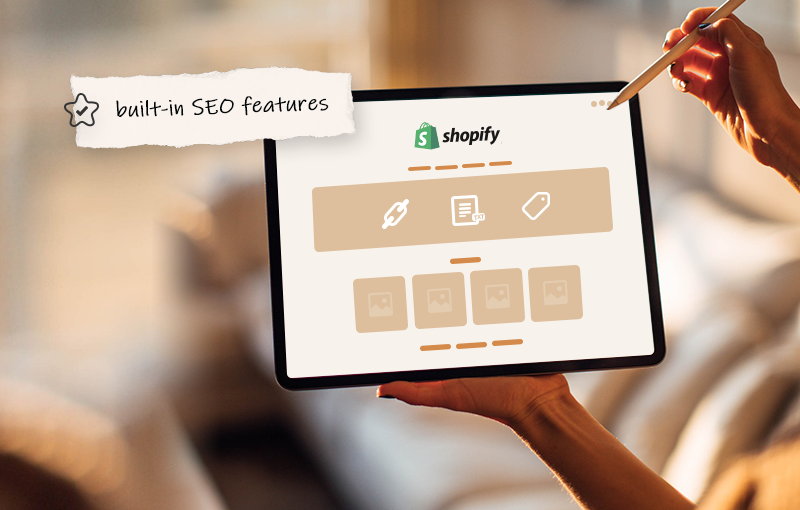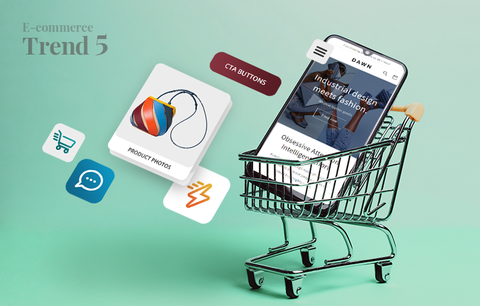
SEO is a lot like a mountain trail - unpaved, wild, steep, adventurous, ever-changing, sometimes a bit cruel... but once you reach the spot with the magnificent view, it is totally worth the efforts!
And just like every traveler needs a map, a compass, and something to light their way so that they don't get lost, SEOs need certain guidelines to keep them on the right track.
Today, in the hopes of making the SEO trail a little easier for you, we shed light on the following issues:3 things you need to know about Shopify SEO
I. You need to target product-focused keywords which show clear buying intent
SEO is all about getting more traffic. But different businesses need different types of traffic. E-commerce businesses need traffic that converts.
To put it another way, if you run a blog, for example, you can target informational keywords because your goal is to provide information. But if you run an online store, you need to target commercial keywords because your goal is to sell your products. In other words, e-commerce SEO is all about targeting product-focused keywords that show clear buying intent. It is key that these keywords are relevant to your business.
However, this doesn’t mean that you must not target informational keywords altogether. If your store has a blog, targeting informational keywords is recommended - providing extra value (such as information) to your customers can benefit you in numerous ways: it will build your credibility, it can get you more exposure on social media, and, ultimately, it can have a positive effect on your bottom line.
It is also a good idea to include informational keywords, long-tail keywords and LSI keywords in your product descriptions and the meta descriptions of your pages - this will help you provide more informed shopping experiences, as well as help search engines understand the content of your website better (which will have a positive effect on your search engine rankings).
II. SEO is for both humans and search engines
Today, SEO is just as much (if not more) about humans, as it is about search engines. Having a perfectly optimized website means nothing if humans don’t find your content and your CTAs engaging. So, to do effective SEO, you need to consider both search engines and your customers.
In terms of search engines, you need to:
- Understand how search engine crawlers work. Search engine bots crawl the web page by page. When a search engine bot crawls a page, it gathers data about it - its topic (including target keywords), its quality, its freshness, its uniqueness. It also gathers data about the links on the page - their number, quality, relevance, etc. After the search engine bot has finished crawling the page, it follows all links on the page and crawls each one of them individually. In other words, search engines discover new pages through links. Thus, link building is an integral part of any successful SEO strategy.
Note: After a search engine bot crawls a web page, it indexes it, it adds it to the SERPs. - Understand which factors search engines take into account when creating the SERPs. This will give you a better understanding of the Dos and Don’ts of SEO. Some of the most important factors which can affect your rankings include your domain authority (DA) score, your site loading speed, the accessibility of your website, the relevance of the keywords you target, the page hierarchy, the URL structure and the navigation structure of your website, the uniqueness, quality and freshness of your content, the number, relevance and quality of your backlinks, outbound links, internal links, and more.
- Understand what a Crawl Budget is & how you can optimize it. Your Crawl Budget is the number of web pages (on your website) a search engine bot can crawl and index within a specified time period. Websites have limited Crawl Budgets, i.e. search engines can crawl a limited number of pages per website (for a limited period of time). If your website has more pages than search engines can crawl, some of your pages will not be crawled. Which means that they will not be indexed either. Therefore, it is essential that you optimize your Crawl Budget. One great way to do this is to create a strong and streamlined website architecture. To create such an SEO-friendly website architecture, you need to create a low-depth page hierarchy, a logical URL structure, and an intuitive website navigation structure.
- Write meta titles and meta descriptions that are both SEO-friendly and engaging to humans.
- Optimize your images for search.
- Understand what structured data is, how it works, and what data types and properties you need to add to your Shopify website.
- Create a strong link-building strategy and more.
In terms of humans, you need to:
- Understand how your customers speak and how they search for products like yours online. This will help you find high-value product-focused keywords that will drive targeted traffic to your Shopify store. Learn more about keyword research for Shopify
- Understand your customers' pain points and tailor your product descriptions, newsletters, sales banners, blog posts, etc. to your customers. In other words, you need to address your customers’ problems and provide solutions. Once you do this, you will no longer offer just a product - you will offer a solution to your customers’ problems.
- Understand what drives your customers to make a purchase (e.g. free delivery, next-day delivery, a small discount on their next order, etc.). This will help you offer better incentives and write more effective CTAs which will increase your CTR (which, in turn, will have a positive effect on your rankings).
- Make sure that your messages clearly convey what makes your product unique and why someone should buy such products from you, i.e. explain what sets you apart from your competitors.
To sum up, to do effective SEO, you need to master the art of technical SEO, as well as understand your buyers' psychology (and shopping behavior).
III. Think of the long-term value
Understand that seeing the results of your SEO efforts takes time. Rome wasn’t built in a day… and neither was any successful SEO strategy. It will take months before your SEO efforts start paying off. If your domain is brand new and your domain authority (DA) score is lower, it can take up to 6 months before you see your web pages on the first page of the SERPs. You need to be patient, because, ultimately, SEO is a long-term investment. Acknowledge this and remember that if you're persistent your efforts will pay off.
Built-in SEO features in Shopify
- Shopify automatically generates your website's sitemap. Your sitemap (or sitemap.xml) is a URL inclusion protocol that tells Google which pages of your website are available for crawling. To view your website’s sitemap, add “/sitemap.xml” to your domain’s URL (e.g. https://myshopifystore.com/sitemap.xml). To help Google index your web pages faster, you should submit your sitemap to Google Search Console. See how to submit your sitemap to Google Search Console
- Shopify automatically generates your website’s robots.txt - a URL exclusion protocol that tells Google which pages of your website not to crawl. To view your website’s robots.txt, add “/robots.txt” to your domain’s URL (e.g. https://myshopifystore.com/robots.txt). Note that in Shopify, store owners cannot edit their website’s robots.txt files.
- Shopify automatically generates canonical tags and adds them to your URLs. Why is this important in the context of e-commerce? There are many ways to reach a product page (e.g. through the www. version of your website, or through the non-www. version of your website; through the different localized versions of your website, and more). In addition, there are other factors that can change the URL of a page. For example, if a product has variants, such as different colors, changing the color will change the URL (see an example). All these URLs are different but lead to the same product page. Google can interpret this as duplicate content (which can hurt your rankings and might get you penalized). Enter canonical tags. Canonical tags tell Google which is the original, or the preferred version of the page (and that all other URLs are variations of that page's original URL).
- If you change a page’s URL, Shopify automatically creates a permanent redirect from the page’s old URL to its new URL.

- Shopify themes automatically generate title tags that contain the name of your store. Note that in Shopify, the page title is used as the H1 tag of the page (this is a default setting). In other words, Shopify (also) generates H1 tags that contain the name of your store.
- Shopify themes have built-in social media sharing options.
- You can preview how your product, collection or blog post listings will look on the SERPs.

- You can edit the title tags, the meta descriptions, and the URLs of your product pages, collection pages, and blog posts.

- You can edit the alt text of images.
For product images, hover over the image and click on "ALT" → Edit or enter your new alt text in the “Image alt text” field → Click “Save”.

Image source: Shopify
For blog post covers, go to the “Featured image” section → Click on “Update” → Click on "Edit image" → An "Edit image" window will appear. Edit the image alt text or enter new image alt text in the “Image alt text” field.

For images in blog posts (and images on other web pages), click on the image, then click on “Edit image”.

An “Edit Image” window will open.

Edit the image alt text or enter new image alt text in the “Image alt text” field.

In Shopify, you cannot edit image file names. If you want to change the file name of an image that has already been uploaded to Shopify, you have to delete the image and upload it again after you’ve edited its name. Therefore, the best practice is to make sure that an image file name is optimized for search before you upload the image to your Shopify store.
To learn more about the built-in SEO features in Shopify, read this SEO Overview by Shopify.
Wrap-up
In this article we discussed 3 important aspects of Shopify SEO:
- You need to target product-focused keywords which show clear buying intent and are relevant to your business - these are the keywords that will drive targeted traffic to your Shopify store
- You need to optimize your Shopify store with both your customers and search engines in mind
- SEO is a long-term investment, so, you need to think of the long-term value, not the short-term benefits
We also talked about the built-in SEO features in Shopify:
- Shopify automatically generates your store's sitemap.xml and robots.txt
- Shopify automatically sets canonical tags and adds them to your URLs
- Shopify automatically creates permanent URL redirects
- Shopify automatically generates SEO-friendly title tags and H1 tags
- Shopify offers a "Search engine listing preview" option
- You can edit the title tags, the meta descriptions, and the URLs of your pages
- You can edit the alt text of images (but you cannot edit image file names in Shopify)
We hope this guide gave you a better understanding of Shopify SEO and the SEO features Shopify offers out-of-the-box. If you have any questions or remarks, do not hesitate to drop us a line in the comments.



